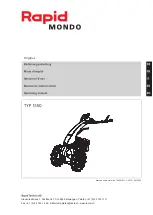
IonPac CS14 Manual
Doc. No. 034848-10
Page 45 of 54
6.2
Preparation of Eluents
A.
Make sure that the eluents and regenerant are made correctly.
B.
Make sure that the eluents are made from chemicals with the recommended purity.
C.
Make sure that the deionized water used to prepare the reagents has a specific resistance of 18.2 megohm-cm.
6.3
A Contaminated Guard or Analytical Column
Determine if the column is contaminated.
Column contamination can lead to a loss of column capacity since all of the cation
exchange sites will no longer be available for the sample ions. Polyvalent cations may be concentrating on the column over a
series of runs. Remove the IonPac CG14 Guard and CS14 Analytical Columns from the system. If the background conductivity
decreases, the column(s) is (are) the cause of the high background conductivity. Clean or replace the CG14 at the first sign of
column performance degradation (compared to the original test chromatogram) to eliminate downtime. Clean the column(s) as
instructed in “Column Care.” To make sure that contaminated hardware is not causing the high background, use deionized
water with a specific resistance of 18.2 megohm-cm as eluent. The background should be less than 1 µS. If it is not, check the
detector/conductivity cell calibration by injecting deionized water directly into it. See the appropriate manual for details.
A.
Check for a contaminated Gradient Mixer.
Gradient Mixers (GM-2) in the Gradient Pump Module should be flushed
thoroughly to remove eluents containing DL-2,3-diaminopropionic acid monohydrochloride (DAP
.
HCl). Chloride
containing eluents should not be pumped through the CSRS ULTRA.
B.
Use chemicals and deionized water of the proper purity.
Be especially careful to make sure that the recommended
chemicals are used. The deionized water should have a specific resistance of 18.2 megohm-cm.
C.
The system should be as metal-free as possible.
Gripper tubing fittings in the system are a potential source for metal
contamination of the column. The new Dionex ThermoFlare or PEEK ferrule fittings are preferred. Inspect the eluent
pumps periodically for any signs of leakage.
D.
Glass eluent reservoirs can be a source of sodium contamination in the eluent.
Two-liter polyethylene eluent
reservoirs (P/N 039163) are preferred.
E.
Install an IonPac Cation Trap Column (CTC-1, P/N 040192).
It should be positioned between the pump and the
injection valve. It is highly recommended for all cation gradient analyses. The CTC-1 strips the eluent of cation
contaminants that will bind strongly to the analytical column resulting in the loss of column capacity and potentially
interfering with the desired cation analyses. The CTC-1 minimizes baseline changes when performing gradient
anlyses. The CTC (2-mm), P/N 043132, should be used in 2-mm systems.
6.4
High Background or Noise
In a properly working system, the background conductivity using the operating conditions described in Section 4,
“Operation,” should be < 1 µS with a CSRS ULTRA.
A system with a high background (> 3 µS) will probably also have high noise, resulting in increased detection limits.
A.
Make sure that the eluents and regenerant are prepared correctly (see Section 5.2, “Eluent Preparation”).
B.
Determine if the columns or system are contaminated (see Section 6.3, “A Contaminated Guard or Analytical
Column”).
C.
Determine if the Suppressor is the cause of the high background and/or noise.
If the above items have been
checked and the problem still persists, the suppression system is causing the problem. See Section 6.5, “A Suppressor
that Does Not Suppress Properly.”










































